Blocks and Features
This page provides explanations of some of the main blocks and underlying concepts of Create.
If we haven't gotten around to documenting what you were looking for, consult the following:
- The Mod JEI for showing the recipes and recipe types added in Create
- The in-game tooltips of Create for description of the individual blocks and items
For Additional feedback and help please see our Discord.
Mod spotlights
Mod spotlight by direwolf20 are YouTube videos introducing Create concepts and features. Not that the videos describe an earlier version of Create and many features have been updated: Part 1, Part 2, Part 3. Part 4
The Basics of Rotation
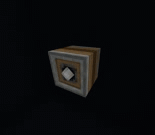
Many machines and components in Create require Rotational Force to operate. Rotational force is generated by several Kinetic Sources such as the ![]() Hand Crank and the
Hand Crank and the ![]() Water Wheel. Rotation can then be transmitted to Kinetic Appliances which perform a variety of actions such as a
Water Wheel. Rotation can then be transmitted to Kinetic Appliances which perform a variety of actions such as a ![]() Crushing Wheel or a
Crushing Wheel or a ![]() Mechanical Saw.
Mechanical Saw.
Rotational force has three characteristics: direction (clockwise, counter clockwise), speed in revolutions per minute (rpm), and Kinetic Stress (or power) measured in Stress Units (SU). Kinetic sources provide a specific number of stress units depending on the configuration of the source. Each kinetic appliance uses a certain number of stress units depending on the type of appliance and rotational speed. When the total number of stress units required by the attached appliances exceeds the number of stress units provided by the kinetic source, the kinetic source stops completely until the required stress units are reduced.
Generating Rotational Force
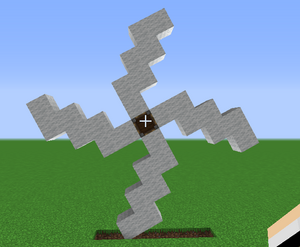
Rotational Force can be generated with the following Create components:
speed of the other.
Powering the large cogwheel results in the smaller one turning at double the speed
Powering the small cogwheel results in the larger one t Hand cranks and valve handles must be turned manually by a player and are generally slow and of low power. Water wheels provide slightly higher power and speed. They must be placed in running water after which they will operate continuously. Windmills are the next step up in power and speed, providing up to 25 times as much power as a water wheel. Steam engine provide the most power but also require continuous sources of heat.
Transmitting Rotational Force
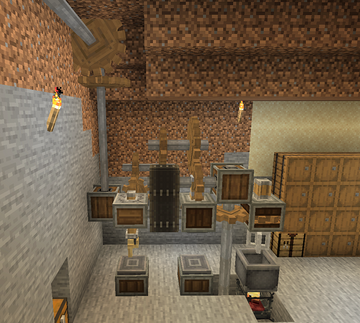
Rotation can be transmitted in a straight line using a ![]() Shaft,
Shaft, ![]() Mechanical Belt, or
Mechanical Belt, or ![]() Encased Chain Drive. The direction can be turned 90 degrees using a
Encased Chain Drive. The direction can be turned 90 degrees using a ![]() Gearbox or
Gearbox or ![]() Large Cogwheel. The rotation can be temporarily stopped using a
Large Cogwheel. The rotation can be temporarily stopped using a ![]() Clutch and can be reversed with a
Clutch and can be reversed with a ![]() Gearshift
Gearshift
The image to the right illustrates rotational power coming in from the top left via a length of connected shafts. The direction is turned 90 degrees downward using two large cogwheels. The vertical shaft then powers a gearbox that turns the direction of rotation to the right where a series of cogwheels, mechanical belts and gearboxes power a ![]() Deployer, a
Deployer, a ![]() Mechanical Press, and a
Mechanical Press, and a ![]() Mechanical Mixer.
Mechanical Mixer.
These transmission components only transfer, stop, or convert rotational power. They do not consume any power or change the speed of rotation.
Changing Speed
Just having components rotate is not always enough. Sometimes it is necessary to control the speed of rotation. This is especially important for machines that require a minimum level of speed to operate (e.g. the Mechanical Mixer). To make this possible, some kinetic blocks have the ability to speed up or slow down connected components:
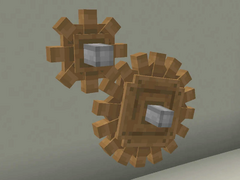
Cogwheels
Cogwheels are not only useful for relaying rotation, but also serve as a simple way to control the speed. By attaching a large cogwheel diagonally to a regular sized one, one can double/half the speed of the other.
Powering the large cogwheel results in the smaller one turning at double the speed.
Powering the small cogwheel results in the larger one turning at half the speed.
Adjustable Chain Gearshift
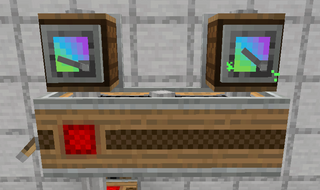
The ![]() Adjustable Chain Gearshift when used in combination with
Adjustable Chain Gearshift when used in combination with ![]() Encased Chain Drives, gives finer control over speed than cogwheels. It can increase input speed for attached chain drives, or decrease output speed of shafts connected to chain drives.
Encased Chain Drives, gives finer control over speed than cogwheels. It can increase input speed for attached chain drives, or decrease output speed of shafts connected to chain drives.
While acting as an input, the adjustable chain gearshift will increase the speed of attached encased chain drives based on the analog redstone signal it receives. A full power redstone signal of 15 will double the speed of the chain drives while values below 15 will increase the speed proportionally between 1x and 2x. While acting as an output, it will reduce the speed of the chain drive in a similar manner. With no redstone signal, the speed will remain unchanged.
Rotation Speed Controller
While having a more expensive recipe, the ![]() Rotation Speed Controller also has the finest control over speed change. When a large cogwheel is attached to the controllers top, it will try its best to keep it spinning at the speed configured in the scroll field. When holding down shift while scrolling, the speed will increase/decrease by 1.
Rotation Speed Controller also has the finest control over speed change. When a large cogwheel is attached to the controllers top, it will try its best to keep it spinning at the speed configured in the scroll field. When holding down shift while scrolling, the speed will increase/decrease by 1.
Stress Units
The machine/component blocks that do have a speed requirement will also have a stress impact
- These blocks include:
- Mechanical Piston (sticky and non-sticky)
- Mechanical Press
- Millstone
- Crushing Wheels
- Mechanical Mixers
- Mechanical Saw
- Deployer
- Mechanical Drill
- Mechanical Crafter
- Rope Pulley
- Clockwork Bearing
- Mechanical Bearing (unless used for power generation)
- Encased Fan (unless used for power generation)
- Cuckoo Clock
- Mechanical Belts
Materials
Create adds a few crafting ingredients for use throughout the mod. While some of them have few uses within Create itself at the moment, they are still handy connection points for pack-makers.
- Andesite Alloy, used for Andesite Casing and all the low-tier kinetic components.
- Brass, used in Brass Casing and more advanced kinetic blocks. Entry-point to the logistical components.
- Copper, generates in the world around surface level. Used for Copper Casing and fluid handling components, and used with Zinc to make Brass.
- Zinc, generates in the world. Used with Copper to make Brass.
Other Materials
- Cinder Flour, made from crushing Netherrack.
- Polished Rose Quartz, made from using Sand Paper on craft-able Rose Quartz. Used in the crafting of Electron Tubes and mixing of Chromatic Compound.
- Powdered Obsidian, made from crushing Obsidian. Used in several filling recipes and in the compacting of Blaze Cake Bases.
Moving Contraptions
Create allows you to move and animate block structures of any shape or form. This feature is extremely powerful as it proves useful in the field of automation, transportation and aesthetics.
In order to get the most out of this mechanic, it is helpful to know about the components and interactions involved in creating such structures.
- Contraption Controllers
- Contraption Assembly and Chassis Blocks elongated chonks
- Portable Storage
- Portable Actors
Contraption Controllers
- Depending on the use case, different controllers can be used for mounting your structure. Some push, some pull, some rotate and some do it all at once.
- These blocks have specific spaces where the anchor of the structure needs to be, and some can be configured to react differently to being stopped.
Mechanical Piston
Mechanical Pistons are kinetically powered counterparts to Minecraft's Pistons. As such, they can push a line of blocks in front of them, and if sticky, pull the closest one back.
However, Create's pistons do not work on their own. They require Piston Extension Poles added at the back, in order to be able to extend. When rotated, the piston will extend exactly as far as poles have been added to the back, rather than just 1 block space.
Rope Pulley
The Rope Pulley moves attached blocks and structures vertically. Use Chassis, Slimeballs or Super Glue to move more than a single block.
When Powered by kinetics:
Starts moving the attached structure.
Speed and direction correlate to the incoming Rotation Speed.
Mechanical Bearing
The Mechanical Bearing is used for rotating larger structures with rotational force.
When Powered by kinetics:
Starts rotating the attached blocks.
Use Chassis, Slime or Super Glue to move more than a single block. Blocks that attach to other blocks, such as levers, torches, or a Mechanical Saw will become part of the structure automatically.
Other attached Mechanical Bearings, if facing along the same axis as the original, will keep their alignment as the original rotates.
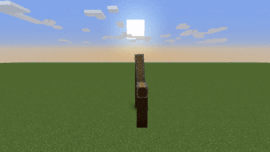
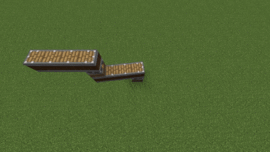
Clockwork Bearing
The Clockwork Bearing is an advanced version of the Mechanical Bearing for rotating up to two clock hands according to the current in-game time.
When Powered by kinetics:
Starts rotating the attached structure towards the current hour. If an independent second structure exists in front of the first one, it will serve as the minute hand.
Cart Assembler
When placed on a Rail, the Cart Assembler can assemble and disassemble moving structures onto passing minecarts. Similarly to rotating structures, having a Mechanical Bearing in the structure will cause the attached part to keep the same alignment as the cart moves.
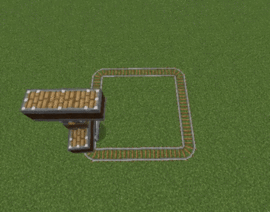
Single Cart Contraptions
Single Cart contraptions as well as Carriage contraptions can carry items, liquids, or mobs, provided they have the correct storage blocks. They can also use the Mechanical Saw, Drill, Harvester, Plough or the Portable Storage Interface to interact with the world.
Carriage Contraptions
Carriage Contraptions are about the same, except their movement is smoother and thus it is easier to walk or ride on them without falling off.